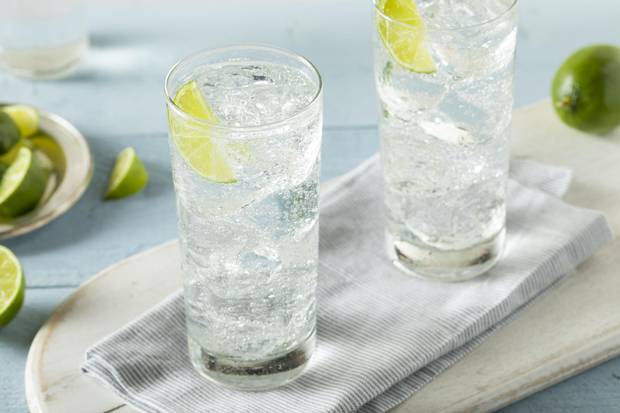It's the quintessential summer drink, as easy to mix as it is refreshing to enjoy—the gin and tonic. Pour a measure of gin over ice, add two to three times that amount of tonic, and the result is pure, thirst-quenching summer satisfaction, lime wedge optional.
But is it really that simple? With so many gins on the market and more options for tonic than we've ever seen before, we wondered if it was time to re-think the G&T. Is it worth trading up to premium gin? What about those fancy boutique tonics? To find out, we set up a more-or-less scientific study we called the Ultimate Gin & Tonic Challenge.
The Method: Three rounds, three styles of gin: traditional London Dry; modern and more botanically-driven; and the wild-cards, with odd ingredients or unusual flavourings. We populated each category with five contenders for a total of 15 gins, each blind-tasted by a group that included a half-dozen drinks writers. To level the playing field, we chose Fever-Tree Indian tonic as our default mixer and used a two-to-one ratio of tonic to gin, identified in a recent study as the near-perfect mix.
Round One: London Dry
Definition: Despite its name, this gin can be made anywhere, with the "dry" part the most important, since no sugar or flavour may be added post-distillation. London dry gins tend to be juniper-forward, with spicy or citrus flavours in support, and are likely used in the vast majority of G&Ts.
Contestants: Beefeater, Tanqueray 10, Sipsmith, Caorunn and Ontario's own Dillon's No. 7.
Given that the G&T was founded upon the idea of London dry blending well with the quinine taste of tonic, it was no surprise that all were very good. Dillon's had the most esoteric flavour profile; Beefeater, a classic taste. Sipsmith, which makes a smashing martini, was subjugated by the tonic, while Tanqueray 10 surprised with a really strong showing despite its perfumey nature. Still, in this nearly dead heat, bold and tasty Caorunn inched out the rest.
Round Two: Botanical
Definition: This "style" of gin is at best loosely defined and not governed by any set of regulations. As such, it features a wide range of botanicals, from cardamom to wintergreen and rose to foraged spruce tips.
Contestants: Bacur, The Botanist, Hendrick's, Victoria, Bloom
Botanical-forward gins are, by definition, individualistic and complex, which makes comparisons tough. When mixed with tonic, Bacur had a distinct lemon-oil flavour and aroma, but the tonic flattened Hendrick's signature cucumber and washed away Bloom's ample botanicals. In the end, Victoria Gin and the Botanist battled it out, with tasters who liked a little hit of anise preferring the former and lovers of more aromatic complexity favouring the latter. Since there could only be one winner, we opted for the comparative straight-forwardness of Victoria.
Round Three: Wild Cards
Definition: These attention-seeking gins are the ones that come in unusual colours, make a virtue of botanicals that sound imaginary, or are distilled from fruits and vegetables you didn't even realize could be fermented.
Contestants: Ungava, Piger Henricus, Rendle's, Gin Mare, Whitley Neill
As expected, this round was all over the map. The tonic clashed with the Arctic botanicals of Ungava, while its bold taste overrode the impressive nuances of pretty pink Rendle's and savoury Spaniard Gin Mare. Fruity Whitley Neill seemed a bit too sweet in the drink. Winner Piger Henricus, made from parsnips in Quebec, had a distinctly earthy character that kept everyone coming back for more.
The Ultimate G&T Gin: For our final battle, the three category winners were again mixed with Fever-Tree, prompting fierce and sometimes heated debate. In the end, however, the beautiful balance of Caorunn won the day.
Bonus Round: The Tonics
Definition: From a one-time choice of Schweppes or Canada Dry, the world of tonic water has exploded into dozens of boutique tonic waters and syrups, many of which are made in Canada and come in pretty packages.
Contestants: Packaged tonics included Fever-Tree Indian; Fever-Tree Mediterranean; Franklin & Sons; Canada Dry. Tonic syrups used were Jack Rudy; Third Place Tonic; ¾ Oz. Tonic Maison. All were paired with our winner, Caorunn, and runner-up, Piger Henricus.
In a way, this was the most surprising round, with stark contrasts between the mixers. Third Place was bold, totally overwhelming the Caorunn; Tonic Maison was nice, but esoteric; Fever-Tree Mediterranean and Canada Dry were too sweet; and Jack Rudy so light it almost faded away. In the end, it was Fever-Tree Indian Tonic that allowed the gin to fully shine.
With the Piger Henricus, the differences were even more stark. Franklin & Sons and Fever-Tree Mediterranean each came alive with the parsnip gin, while Tonic Maison produced a result that was esoterica squared, deliciously different but no longer really in the gin and tonic wheelhouse.
Take-Away: What we learned was that what works in a martini or gin fizz isn't necessarily going to make the finest G&T, and vice versa. Because gins are complex animals, as are modern tonics, making the right match is crucial. A good rule of thumb is to use sweeter tonics like Fever-Tree Mediterranean and Franklin & Sons for botanical gins, drier ones like Fever-Tree Indian for London dry gins, and when using tonic syrups, play around with the mixing proportions to find what works best for you.
Visit tgam.ca/newsletters to sign up for the Globe Style e-newsletter, your weekly digital guide to the players and trends influencing fashion, design and entertaining, plus shopping tips and inspiration for living well. And follow Globe Style on Instagram @globestyle.




